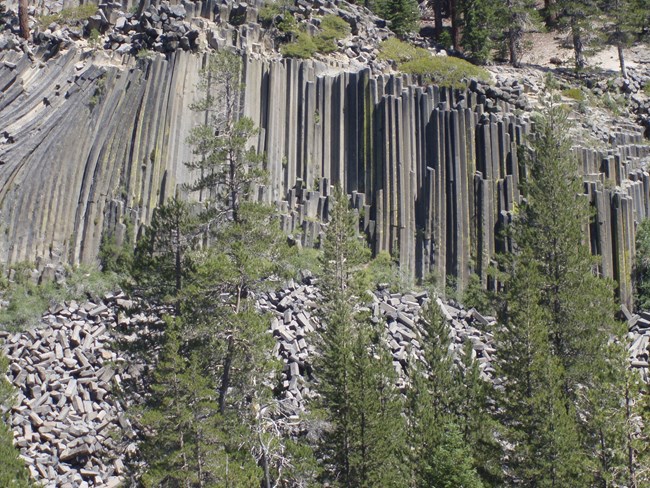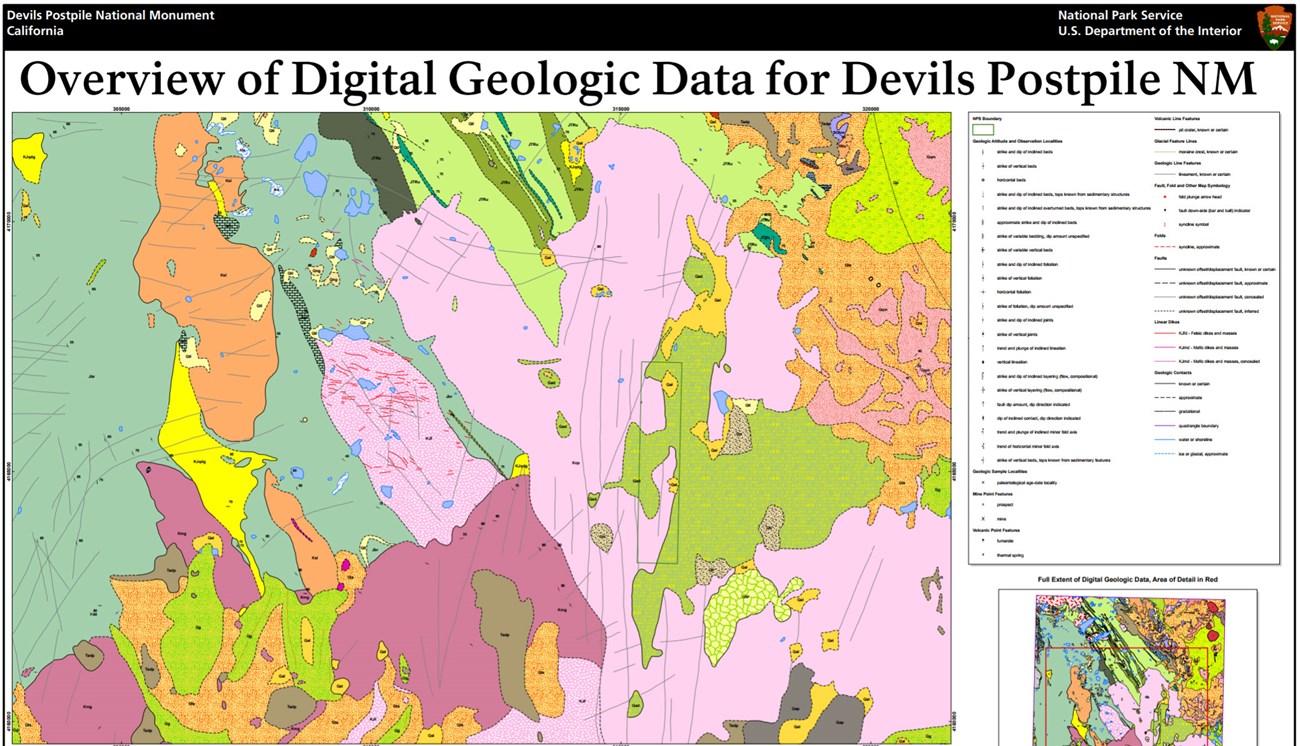Last updated: June 17, 2024
Article
NPS Geodiversity Atlas—Devils Postpile National Monument, California
Geodiversity refers to the full variety of natural geologic (rocks, minerals, sediments, fossils, landforms, and physical processes) and soil resources and processes that occur in the park. A product of the Geologic Resources Inventory, the NPS Geodiversity Atlas delivers information in support of education, Geoconservation, and integrated management of living (biotic) and non-living (abiotic) components of the ecosystem.

Geologic Features and Processes
Devils Postpile National Monument, established in 1911, lies southeast of Yosemite National Park in the Sierra Nevada of California. Although a relatively small western national monument, it contains world-renowned examples of vertical columnar basalt. Features exposed in Devils Postpile National Monument owe their origin to both fire and ice. Volcanic eruptions, igneous intrusions, and mountain-building processes tied to the tectonically active margin of western North America created the raw material from which Pleistocene glaciers carved the park’s distinct landscape. Today, the Middle Fork of the San Joaquin River meanders through a glacially-carved valley that once supported a river of ice.
Devils Postpile National Monument contains rare geologic features—polygonal columns of Quaternary basalt, the “posts” for which the monument is named. In addition to the basalt columns, Quaternary (2.6 million years ago to the present) extrusive volcanic rocks and Cretaceous (145.5 to 65.5 million years ago) intrusive igneous rocks form the landscape of Devils Postpile National Monument. These rocks range in composition from granodiorite to leucogranites (granites rich in potassium feldspar and aluminum).
[Please be aware that no collecting of geologic material is permitted. Under Federal law, all park features and resources are protected. Anyone with information about illegal activities or who would like to report suspicious activity in the national parks should contact an on-site ranger or submit a tip to NPS Investigative Services. No collecting of park geologic resources for for classroom educational purposes is permitted and collecting for scientific research requires an approved Scientific Research and Collecting permit.]
Devils Postpile
The 12 to 18 m (40 to 60 ft) high columnar basalt of the Devils Postpile ranks as one of the world’s finest examples of columnar basalt. About 100,000 years ago, a volcano erupted north of Pumice Flat and filled the valley of the Middle Fork of the San Joaquin River with runny basaltic lava. The lava flowed at least 5 km (3 mi) downstream and accumulated in the vicinity of the Devils Postpile to an exceptional depth of approximately 122 m (400 ft) (Huber and Eckhardt 2002). The basaltic lava was very fluid and remained molten while it pooled in the valley behind a natural dam (e.g., a glacial moraine). To form columns that are so much longer than those formed from a typical basalt flow, the lava behind the natural dam had to be remarkably deep. After the lava solidified, glacial erosion removed approximately half of the flow, leaving the thick center exposed (Allen Glazner, University of North Carolina, written communication, June 10, 2009).
The top and bottom of the lava cooled and solidified rapidly because of exposure to air and cooler granite bedrock. As the solidifying lava cooled from the outside surfaces inward, it also shrank, as do virtually all liquids when frozen or solidified. With shrinkage, tensional stresses developed in the lava. The column formation is summarized as follows (Huber and Eckhardt 2002):
- Surface cracks developed when the tension caused by the shrinkage of cooling was greater than the strength of the lava.
- As cracks reached about 25 cm (10 in), they branched to form a Y-shape with equal angles of approximately 120 degrees around all sides, an angle that provides the greatest stress relief.
- Each new crack branched again when it reached the critical length, and together with other similar cracks formed an irregular polygonal pattern.
To form exceptionally long, uniform, vertical columns, a lava flow must be of uniform thickness, be homogeneous in chemical composition, and have level top and bottom cooling surfaces. Irregularities in chemical composition or thickness result in tilted or curved columns. Columns exhibiting extreme curvatures formed adjacent to the rare vertical columns at Devils Postpile National Monument.
Other Volcanic Features
In addition to the basalt of Devils Postpile, other volcanic features are present in the monument area. The Buttresses, a feature composed of the oldest volcanic unit in the park, resulted from lava that erupted from vents west of Devils Postpile National Monument. A lava flow composed of the volcanic rock rhyodacite is responsible for the cliff at Rainbow Falls on the Middle Fork of the San Joaquin River. Dense hard volcanic tuff from the catastrophic eruption that produced the 16- by 32-km (10- by 20-mi) Long Valley Caldera is exposed behind the old ranger cabin east of Reds Meadow. Remains of a 10,000-year-old basalt flow and cinder cones are preserved at Red Cones, about 2.4 km (1.5 mi) southeast of Devils Postpile National Monument.
Rainbow Falls
Rainbow Falls Plummeting 31 m (101 ft) over a cliff of volcanic rock, Rainbow Falls presents a striking contrast of whitewater against black, volcanic cliffs (fig. 12). Located near the southern end of the monument about 4 km (2.5 mi) from the Ranger Station, Rainbow Falls is the highest waterfall on the Middle Fork of the San Joaquin River (fig. 1). On sunny summer days, rainbows appear in its mist.
As water cascades over the cliff, the less resistant rock at the base of the falls wears away in a process known as “undercutting.” Undercutting erodes the softer rock, creating an alcove, or cavern, beneath the massive layer. As the upper layer loses its support, it eventually caves in and breaks into boulders and rock debris at the bottom of the falls.
Glacial Features
Numerous episodes of Pleistocene glaciation carved the jagged peaks and U-shaped valleys of today’s Sierra Nevada (Kiver and Harris 1999). The alpine glacier that flowed down the Middle Fork of the San Joaquin River scoured and scraped away most of the Devils Postpile lava flow about 10,000 to 12,000 years ago. The river of ice eroded most of the lava flows in the area, but left some remnants of the original lava flows. The glacier cut a vertical face on the remnant known as the Devils Postpile, exposing the interior of the flow and the sides of the columns.
The top of the Devils Postpile reveals not only a cross section of the polygonal pattern of the posts, but also the polished and scoured effects of flowing ice. As the glacier flowed down the valley, fine silt that was embedded in the ice acted as nature’s scouring pad and polished the ends of the columns. Pebbles, boulders, and other coarse debris scraped across the columns, producing parallel striations and grooves in the basalt.
Rounded bedrock exposures within and near the monument that have one steep slope and one gentle slope indicate the direction of ice flow. Glaciers flowing over fractured bedrock tend to pry and pluck blocks of jointed rock away from the downstream side of the outcrop. On the upstream side, abrasive material within the glacier polishes and smoothes the bedrock surface. Plucking action on the downstream side of the rock outcrop creates a steep slope while the polishing action of ice forms a gentle slope that faces upstream. Such a glacial feature is called a “roche moutonnée.”
Glaciers also carried large boulders (glacial erratics) from points upstream and deposited them when the glaciers melted. Many of the glacial erratics in the Devils Postpile area consist of metamorphic rock that only occurs north of the monument.
Regional Geology
Devils Postpile National Monument is a part of the Cascade-Sierra Mountains Physiographic Province and shares its geologic history and some characteristic geologic formations with a region that extends well beyond park boundaries.
- Scoping summaries are records of scoping meetings where NPS staff and local geologists determined the park’s geologic mapping plan and what content should be included in the report.
- Digital geologic maps include files for viewing in GIS software, a guide to using the data, and a document with ancillary map information. Newer products also include data viewable in Google Earth and online map services.
- Reports use the maps to discuss the park’s setting and significance, notable geologic features and processes, geologic resource management issues, and geologic history.
- Posters are a static view of the GIS data in PDF format. Newer posters include aerial imagery or shaded relief and other park information. They are also included with the reports.
- Projects list basic information about the program and all products available for a park.
Source: NPS DataStore Saved Search 2810. To search for additional information, visit the NPS DataStore.
A NPS Soil Resources Inventory project has been completed for Devils Postpile National Monument and can be found on the NPS Data Store.
Source: NPS DataStore Saved Search 2829. To search for additional information, visit the NPS DataStore.

Related Links

